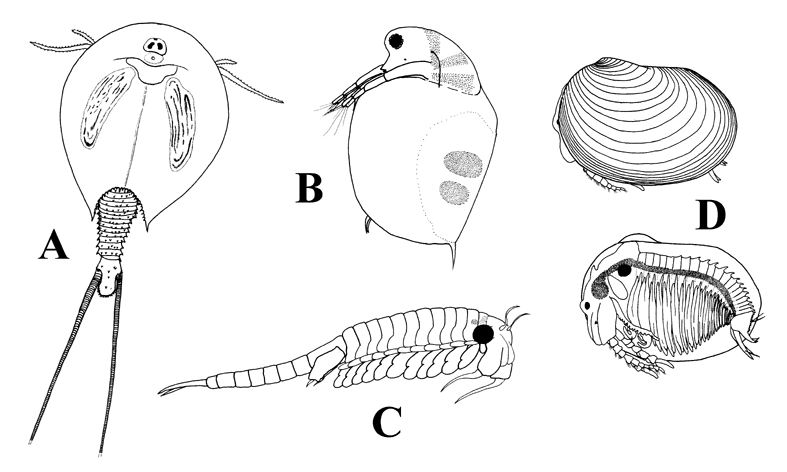Several types of aquatic crustaceans are present in the Rhynie chert. Crustaceans are distinguished from all other arthropods by the fact they possess two pairs of antennary appendages in front of the mouth together with the presence of biramous limbs. Crustaceans form a large and highly diverse group of arthropods that have adapted to a number of different environments ranging from deep sea to shallow marine (e.g. shrimp, crab and lobster) to brackish water and freshwater habitats (e.g. crayfish, water-fleas and tadpole shrimps) and in some instances are fully terrestrial (e.g. the modern woodlouse). The crustaceans found in the Rhynie chert appear to have been aquatic, freshwater-living animals and all appear to belong to the Class Branchiopoda of which the tadpole shrimp Triops, the water-flea Daphnia and the fairy shrimp (e.g. Artemia) are modern examples (see inset below).

Branchiopods ('gill-feet'), sometimes called phyllopods ('leaf-feet'), are generally very small crustaceans characterised by having a variable number of delicate foliaceous and lobed, relatively uniform trunk or body limbs; some types possess a single dorsal cephalothoracic shield, or a bivalve shell (see inset above). They also commonly possess numerous somites or body segments. The abdomen lacks limbs and the tail ends in distinct furcal rami. They tend to occur in continental aquatic habitats ranging from fresh to hypersaline waters.
The earliest known branchiopod, Rehbachiella kinnekullensis (Walossek 1993), from the Orsten rocks of the Upper Cambrian Alum Shale in Sweden, was a marine crustacean. Non-marine branchiopods are known to range from the Early Devonian to the present day and as such those from the Rhynie chert are among the earliest known representatives of this group.
- Relationships
-
The branchiopods, including those found in the Rhynie chert, second only to another group of marine crustaceans called the cephalocarids, are considered to be the most primitive of living crustaceans. This is suggested by the generally homomorphic nature of their somites or body segments and multi-filamentous biramous limbs. The Rhynie branchiopods are particularly important since not only do they appear to represent a lineage from the 'early crustacean design' but they also give an insight into the timing of the adaptation of these crustaceans to continental and freshwater habitats.
- Identity
-
Until recently, only one crustacean was known from the Rhynie chert, Lepidocaris rhyniensis (Scourfield 1926). This comprises the only member of the extinct branchiopod order Lipostraca. Recently, however, a number of new branchiopod crustaceans have come to light, including Castracollis wilsonae (Fayers and Trewin 2003) from the Rhynie chert, a branchiopod closely related to the Calmanostraca (e.g. Tadpole Shrimps); and for the first time branchiopod larvae or nauplii have been discovered in the Windyfield chert. Another enigmatic branchiopod-like crustacean, Ebullitiocaris oviformis, with a univalve 'carapace' from the Rhynie and Windyfield cherts has recently been described by Lyall I. Anderson and others (Anderson et al. 2004), and will be added to this resource in due course.
Click on the name to see images and a description of the animal.
- Lepidocaris rhyniensis
- Castracollis wilsonae
- Branchiopod larvae
- Ebullitiocaris oviformis
